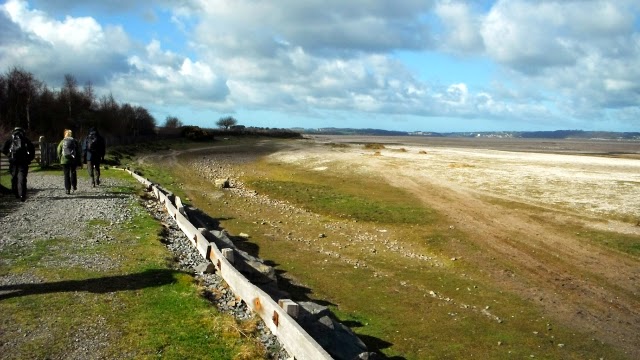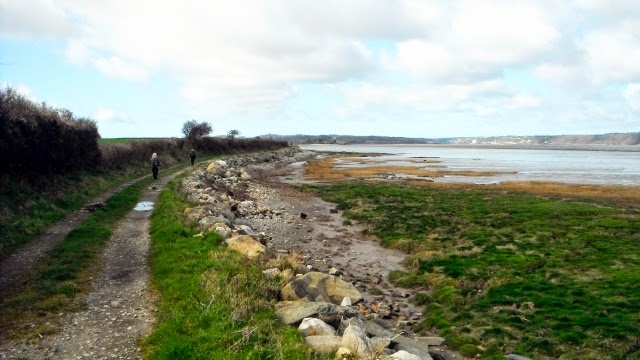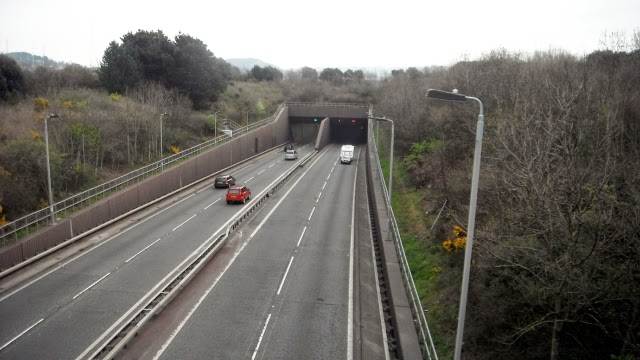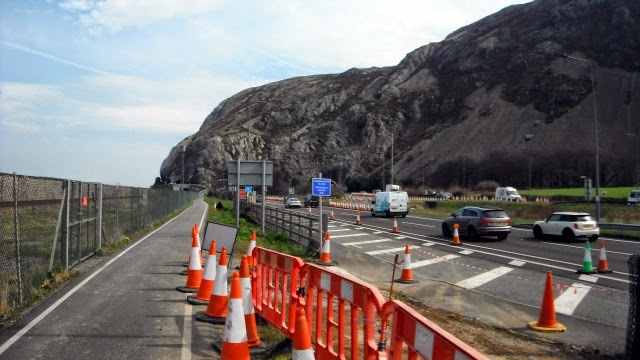CHESTER TO THE MENAI BRIDGE
DAY SEVEN - LLANFAIRFECHAN TO THE MENAI BRIDGE
The walking up to now had been good and very interesting but not typical of what I have found on the rest of the bits of the Welsh coast that I have walked. Today was going to be different and more typical. We took one car to near the Menai Bridge and then all went in the other to Llanfairfechan to continue from where we left off.
The sea front car park at Llanfairfechan on a very cold and blustery morning. The hills all along the back of the coastline had all received a coating of snow and on the coast it was only just above freezing with a wind chill so we all rushed to wrap up.
The sea front at the view across the Lavan Sands to Anglesey.
A view around the bay of the first section of wild coastal path.
It goes around this bird reserve on a flood embankment
Walking around to Aber Point scene of the former crossings of the Lavan Sands
The path continued protected by the sea defences. We stopped for a coffee hidden behind the remains of a stone wall out of the wind coming across the bay.
Inland we could still see the snow on the hills at the back
The Afon Aber just before it meets the sea. http://en.wikipedia.org/wiki/Afon_Aber
The wild coastline continues from Aber Point first on this vehicular track,
and then on this grassy shoreline.
A view across to Beaumaris on Anglesey.
The coast path has to go inland to get around the estate in which Penrhyn Castle is located and a creek at the outfall of the Afon Ogwen that runs through it. Afon = river.
Aerial views of the castle = https://www.youtube.com/watch?v=IpuYtrshw_A
The route involves going inland to the village of Tal-y-bont, this picture was taken as we followed the coast railway into the village.
The Afon Ogwen which rises in Snowdonia where it goes under the road to enter Penrhyn Park.
A little further on we found a sheltered spot on a roadside wall to have a picnic. After that we crossed the A5 ands went down a lane to the Afon Cegin.
The Cegin valley was heavily industrialised in the 18th and 19th centuries with two separate railway lines conveying slate from quarries in the hills down to Porth Penrhyn to be shipped out to destinations across the world. This is one of them now a cycleway which the North Wales Coast Path uses following closely the pretty river.
The cycleway comes down to here - Port Penrhyn. It was formerly of great importance as the main port for the export of slate from the Penrhyn Quarry, the largest slate quarry in the world at the end of the nineteenth century. It was built, and later expanded, by the Pennant (later Douglas-Pennant) family of the nearby Penrhyn Castle.
View of the port jetty from the west side of the bay at Bangor and some of the headlands as far as Llandudno.
Another view this time from the green at Garth (part of Bangor).
It is at Garth that you will find this Pier. Garth Pier is a Grade II listed structure in Bangor, Gwynedd, North Wales. At 1,500 feet (460 m) in length, it is the second-longest pier in Wales, and the ninth longest in the British Isles. http://en.wikipedia.org/wiki/Garth_Pier
Another view further west as we work our way long the Menai Straits with Anglesey on the other side.
These are Ashley Jones Fields named after a local solicitor who left a bequest for their purchase by the local council During the (Bangor) Eisteddfod in 1931 a stone circle and table were erected as part of the celebrations. Here the route splits - a high tide route follows the left upper side of the fields and a low tide route goes through the stone circle to the bottom right.
Both routes end up at the beach to he right of this white house, the low tide route is along the beach below the woods.
After an undulating section along a wooded coast, and a climb passing Bangor City Football Ground and a walk along part of the A5 we got there - the Menai Bridge.
Pleased with this photo as it shows this engineering wonder off well.
Aerial views of the bridge https://www.youtube.com/watch?v=7at7BtL5s4Q
The history of the bridge http://en.wikipedia.org/wiki/Menai_Suspension_Bridge
All five us completed the mission walking 87.9 miles - not a drop of rain or any incidents it could not have gone better. Thanks to Bob, Dave Jim and Tracey for accepting the challenge and their company.
The next blog will be of the walk across Yorkshire from Kirkby Stephen to Robin Hood's Bay.













































































